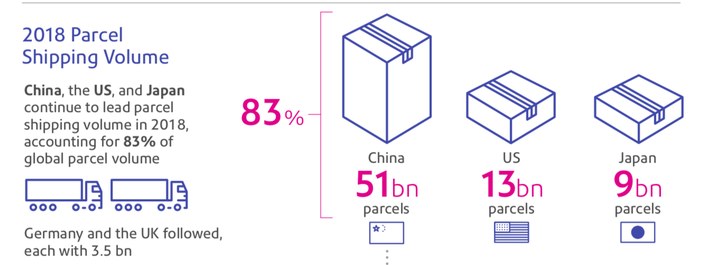Pitney Bowes’ Parcel Shipping Index has revealed that global parcel volumes reached 87 billion in 2018 – the highest since the index began. The annual report forecasts that by 2025, this figure will more than double to 200 billion parcels.
The report reveals growth of 17% in 2018. On average, there were 23 parcels shipped per person in the 13 major markets in 2018, and 2,760 parcels shipped every second.
China remains the strongest influence on the market with 51 billion parcels shipped in 2018. The country extended its global lead in parcel volume, with 26% year-on-year growth and a CAGR of 41% from 2013-18. China’s parcel volume is more than four times that of the USA, which stands at 13 billion. However, the USA’s parcel revenues (at US$119bn) remain higher than China’s parcel revenues of US$91bn.
Emerging markets Brazil and India also saw impressive growth. Brazil’s year-on-year percentage growth in parcel volume reached 25% in 2018 – second only to China – as 738 million parcels were shipped.
India also experienced high growth in parcel volumes in 2018, up 21% year-on-year to 2.5 billion, and revenues achieved CAGR of 20%, boosted by rapid growth in its e-commerce market, higher levels of disposable income and increased internet penetration.
Jason Dies, EVP and vice president of sending technology solutions, Pitney Bowes said, “Global parcel revenues continue to benefit from the explosive impact of e-commerce, but it isn’t just online shoppers boosting the industry. We know from our clients’ own behaviors that office sending is increasing, particularly in industries such as IT, healthcare and manufacturing. Carriers are trialling new and exciting strategies to deliver the best customer experience, to keep costs down, boost productivity and generate profitability, such as forming partnerships, designing next-generation sending technologies, and developing last-mile innovation.”
The Pitney Bowes Parcel Shipping Index spans 13 countries and represents the parcel shipping activity of 3.7 billion people. To read the full report, click here.


